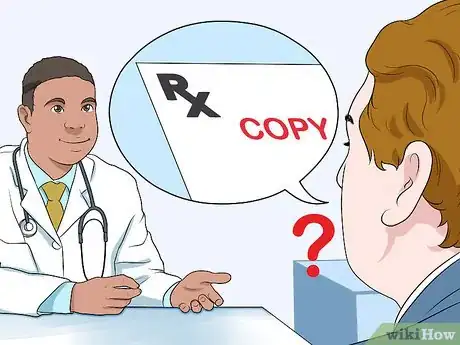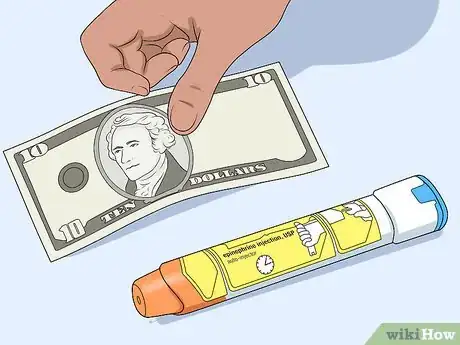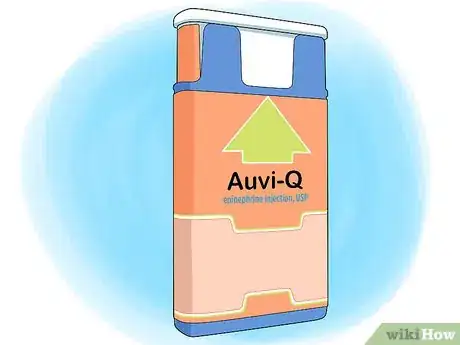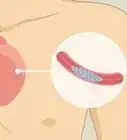This article was co-authored by Alan O. Khadavi, MD, FACAAI. Dr. Alan O. Khadavi is a Board Certified Allergist and a Pediatric Allergy Specialist based in Los Angeles, California. He holds a BS in biochemistry from the State University of New York (SUNY) at Stony Brook and an MD from the State University of New York Health Science Center at Brooklyn. Dr. Khadavi completed his pediatric residency at Schneider Children’s Hospital in New York, and then went on to complete his allergy and immunology fellowship and pediatric residency at Long Island College Hospital. He is board certified in adult and pediatric allergy/immunology. Dr. Khadavi is a Diplomate of the American Board of Allergy and Immunology, a Fellow of the American College of Allergy, Asthma & Immunology (ACAAI), and a member of the American Academy of Allergy, Asthma & Immunology (AAAAI). Dr. Khadavi's honors include Castle Connolly’s list of Top Doctors 2013-2020, and Patient Choice Awards "Most Compassionate Doctor" in 2013 & 2014.
There are 14 references cited in this article, which can be found at the bottom of the page.
This article has been viewed 38,369 times.
EpiPen is an epinephrine auto-injector used to treat a severe allergic reaction called anaphylaxis. If you have life-threatening allergies, it is extremely important to have epinephrine with you at all times. By obtaining and filling an EpiPen prescription, you can ensure you always have access to the medication you need. There are also other epinephrine auto-injector brands and generic medications you can consider, as EpiPens can be expensive.[1] You should also learn how to use your EpiPen before an emergency strikes.
Steps
Obtaining an EpiPen Prescription
-
1Make an appointment with your doctor or allergist.[2] Call your doctor or allergist to make an appointment. Bring any relevant materials to discuss why you believe you need an EpiPen, such as details of recent ER visits or referrals from other doctors.[3]
- You cannot buy an Epi-pen without a prescription. Therefore, if you are travelling or going away on holiday, allow for time to see the doctor beforehand.
-
2Discuss any history of anaphylaxis or troublesome allergy symptoms. At your appointment, talk to your doctor about any recent allergy scares, hospitalizations, or history of anaphylaxis. Symptoms of anaphylactic reactions include trouble breathing, hives, low blood pressure, facial swelling, vomiting, or a weak pulse.[4]
- Common allergens that can cause anaphylaxis include peanuts, nuts, shellfish, and fish.[5]
- Everyday allergy symptoms, such as itchy eyes or a runny nose, should be treated with maintenance medications, such as an inhaled corticosteroid, not an emergency medication like an EpiPen. However, even mild allergens can become life threatening in large quantities. Your doctor can help determine if you are at risk for anaphylaxis and need to carry an EpiPen.
Advertisement -
3Ask if an EpiPen prescription is right for you. Based on your symptoms, talk to your doctor about whether an EpiPen, or another medication, would be most appropriate to treat your allergies. The doctor may perform skin-prick testing or spirometry tests to determine the severity of your allergic symptoms.[6]
- A skin-prick test, which is also called a scratch test, evaluates up to 40 substances at a time to see if they produce an allergic reaction in the patient. A nurse will prick the person with a drop of the allergen to see if there is an allergic reaction.[7]
- A spirometry test is an office exam that allows the doctor to test how much air you inhale at one time, how much air you exhale, and how long it takes you to exhale. This will tell your doctor if you are breathing normally.[8]
-
4Discuss if multiple EpiPen prescriptions are needed. Ask your doctor if multiple prescriptions are necessary so you can have EpiPens at your office, at school, or in your car, depending upon your typical schedule and needs. It's important to carry an EpiPen with you at all times if you have a life-threatening allergy.[9]
- Your doctor can determine how many additional prescriptions, if any, are appropriate. In most cases, no more than 3 are necessary. You may want to get an extra EpiPen to keep at work or give to the school nurse.
-
5Ask for a paper or electronic copy of your prescription(s). Obtain a copy of your prescription so you can fill it at your local pharmacy. Sometimes doctors send prescriptions directly to your pharmacy electronically instead. Have the name, address, and phone number of your preferred pharmacy ready for your doctor just in case.
- If your doctor writes you a paper prescription, store it in a safe place, such as inside your wallet, until you can fill it at the pharmacy. However, remember that prescriptions do have expiration dates. Most expire 3 months after they are written, unless otherwise stated.
Filling an EpiPen Prescription
-
1Search for coupons on the website of the EpiPen's manufacturer. Visit to the EpiPen website operated by Mylan at https://www.epipen.com/paying-for-epipen-and-generic. Browse the available coupons to potentially reduce the price of your EpiPen at the pharmacy. Click the eligibility link under each available coupon to see if you qualify for savings.[10]
- You can save up to $300 in out of pocket costs with coupons, so it's definitely worth exploring!
- Print copies of any coupons you qualify for, and bring hard copies to the pharmacy.
-
2Take your EpiPen prescription to your local pharmacy. Give your written EpiPen prescription to the pharmacist or check that any electronic EpiPen prescriptions have arrived. Give the pharmacist your health insurance card and any coupons you've printed from the manufacturer.
- If you fill medications at other pharmacies, be sure the pharmacist is aware of your full medication regimen so they can counsel you about any potential drug interactions.
- There are approximately 45 known, major drug interactions with epinephrine. Your pharmacist can advise if any of these apply to you. It's important that you doublecheck these issues in advance since you will be using your EpiPen in an emergency and won't have time to stop other medications. Since epinephrine treats life-threatening reactions, though, typically the benefits of using it outweigh the risks.[11]
-
3Ask the pharmacist about any promotions or offers. Inquire about any additional drug discounts or pharmacy promotions that may lower the price of your EpiPen when you give your prescription to the pharmacist. EpiPens can cost more than $600 out-of-pocket without insurance. It never hurts to ask![12]
- If your pharmacy has EpiPens in stock, the prescription should be filled within a day or two. You can pick up your prescription at your convenience when it is ready.
-
4Check your eligibility for Mylan's patient assistance program. Visit Mylan's website and look into your eligibility for financial assistance if the final price of your EpiPen gives you sticker shock. You can also call Mylan customer relations at 1-800-395-3376 or email them at customer.service@mylan.com to get additional program details.[13]
- At present to qualify for Mylan's patient assistance program, you must adhere to these guidelines:
- You need to be a U.S. citizen or legal resident;
- Your gross yearly income must fall 400% below current federal poverty guidelines; and
- You cannot have insurance through a public or private insurer, including federal programs, such as Medicaid.
- There are some exceptions to the existing rules, such as prescription drug-coverage through an insurer that only covers generic products. Contact Mylan for more information.
- At present to qualify for Mylan's patient assistance program, you must adhere to these guidelines:
-
5Write your insurance to appeal a denial for EpiPen coverage. Ask your doctor to write a letter on your behalf in support of your need for an EpiPen. Fill out any appeals paperwork on your insurer's website and submit it along with the letter from your doctor. Try to be patient, as appeals can be a months-long process. During this time, you will need to pay for your EpiPen out of pocket.[14]
- Just because you are denied for EpiPen prescription-drug coverage does not mean you cannot buy an EpiPen. You can proceed with filling your prescription, but you will be responsible for the cost yourself
- If you decide to fill your prescription using your own funds, you may be able to get reimbursed for your EpiPen if your insurer later grants your appeal. This varies by plan. Ask your insurer about the possibility of future reimbursement in case your appeal is granted.
Buying EpiPen Alternatives
-
1Purchase a generic EpiPen for less money. Tell the pharmacist if you are okay with an epinephrine auto-injector that is not the brand name EpiPen. Mylan has created a generic EpiPen for half the price that contains the same active ingredients as the original EpiPen. The pharmacy is typically happy to fill a generic version of the drug rather than brand name, if it is available. However, it's best to ask your doctor to write on the prescription that generics are okay.[15]
- Mylan's generic version of the Epipen—simply called epinephrine injection USP—is currently half the price of the brand-name EpiPen.
- Generic drugs contain the same active ingredients as their brand-name counterparts.
-
2Consider Auvi-Q if you are new to auto-injectors. Look into the Auvi-Q, another brand of epinephrine auto-injector, instead of the EpiPen. A speaker in the Auvi-Q gives verbal directions on how to administer the medication, which is reassuring if you are new to auto-injectors or feel nervous about using one.[16]
- The speaker that gives administration instructions is included on the injector itself.
- Verbal direction can be reassuring in a stressful situation or if the Auvi-Q is for a child who cannot read.
- Auvi-Q is free for families with an income of less than $100,000 regardless of insurance coverage.[17]
-
3Try Adrenaclick if you fill your prescriptions at CVS. Get a low price for an epinephrine auto-injector with the same active ingredients as an EpiPen by choosing Adrenaclick, which offers discounts at CVS pharmacies. With coupons, Adrenaclick's cost can be reduced to $10.[18]
- You don't need insurance coverage to get CVS's preferred pricing on Adrenaclick. Without manufacturer's coupons, Adrenaclick is $110 at most CVS pharmacies.
- You can find coupon's on the manufacturer's website: http://epinephrineautoinject.com/.
Expert Q&A
Did you know you can get expert answers for this article?
Unlock expert answers by supporting wikiHow
-
QuestionWhat allergies require an epi pen?
 Alan O. Khadavi, MD, FACAAIDr. Alan O. Khadavi is a Board Certified Allergist and a Pediatric Allergy Specialist based in Los Angeles, California. He holds a BS in biochemistry from the State University of New York (SUNY) at Stony Brook and an MD from the State University of New York Health Science Center at Brooklyn. Dr. Khadavi completed his pediatric residency at Schneider Children’s Hospital in New York, and then went on to complete his allergy and immunology fellowship and pediatric residency at Long Island College Hospital. He is board certified in adult and pediatric allergy/immunology. Dr. Khadavi is a Diplomate of the American Board of Allergy and Immunology, a Fellow of the American College of Allergy, Asthma & Immunology (ACAAI), and a member of the American Academy of Allergy, Asthma & Immunology (AAAAI). Dr. Khadavi's honors include Castle Connolly’s list of Top Doctors 2013-2020, and Patient Choice Awards "Most Compassionate Doctor" in 2013 & 2014.
Alan O. Khadavi, MD, FACAAIDr. Alan O. Khadavi is a Board Certified Allergist and a Pediatric Allergy Specialist based in Los Angeles, California. He holds a BS in biochemistry from the State University of New York (SUNY) at Stony Brook and an MD from the State University of New York Health Science Center at Brooklyn. Dr. Khadavi completed his pediatric residency at Schneider Children’s Hospital in New York, and then went on to complete his allergy and immunology fellowship and pediatric residency at Long Island College Hospital. He is board certified in adult and pediatric allergy/immunology. Dr. Khadavi is a Diplomate of the American Board of Allergy and Immunology, a Fellow of the American College of Allergy, Asthma & Immunology (ACAAI), and a member of the American Academy of Allergy, Asthma & Immunology (AAAAI). Dr. Khadavi's honors include Castle Connolly’s list of Top Doctors 2013-2020, and Patient Choice Awards "Most Compassionate Doctor" in 2013 & 2014.
Board Certified Allergist
References
- ↑ https://www.epipen.com/about-epipen-and-generic/what-is-epinephrine
- ↑ Alan O. Khadavi, MD, FACAAI. Board Certified Allergist. Expert Interview. 29 July 2020.
- ↑ https://www.mayoclinic.org/diseases-conditions/anaphylaxis/symptoms-causes/syc-20351468
- ↑ https://www.mayoclinic.org/diseases-conditions/anaphylaxis/symptoms-causes/syc-20351468
- ↑ Alan O. Khadavi, MD, FACAAI. Board Certified Allergist. Expert Interview. 29 July 2020.
- ↑ https://www.mayoclinic.org/diseases-conditions/anaphylaxis/diagnosis-treatment/drc-20351474
- ↑ https://www.mayoclinic.org/tests-procedures/allergy-tests/basics/what-you-can-expect/prc-20014505
- ↑ https://www.mayoclinic.org/tests-procedures/spirometry/about/pac-20385201
- ↑ https://www.mayoclinic.org/diseases-conditions/anaphylaxis/diagnosis-treatment/drc-20351474
- ↑ https://www.epipen.com/paying-for-epipen-and-generic
- ↑ https://www.drugs.com/drug-interactions/epinephrine,epipen-index.html?filter=3&generic_only=
- ↑ https://www.cnbc.com/2016/09/21/mylan-ceo-says-epipen-profits-no-where-near-devices-600-sticker-price.html
- ↑ https://www.epipen.com/paying-for-epipen-and-generic
- ↑ https://www.consumerreports.org/health/4-ways-to-get-insurance-to-cover-your-prescription-drugs/
- ↑ https://www.consumerreports.org/drugs/mylan_to_sell_generic_EpiPen_pack_for_300/
- ↑ https://theoutline.com/post/887/cvs-is-selling-a-super-cheap-epipen-alternative-but-will-people-buy-it
- ↑ https://www.forbes.com/sites/matthewherper/2017/01/19/epipen-competitor-auvi-q-to-be-free-for-most-patients-but-cost-4500-for-insurers-in-rube-goldberg-scheme/#7708a5d83fe6
- ↑ https://www.consumerreports.org/drug-prices/epipen-alternative-that-costs-just-10-dollars/







































































Medical Disclaimer
The content of this article is not intended to be a substitute for professional medical advice, examination, diagnosis, or treatment. You should always contact your doctor or other qualified healthcare professional before starting, changing, or stopping any kind of health treatment.
Read More...